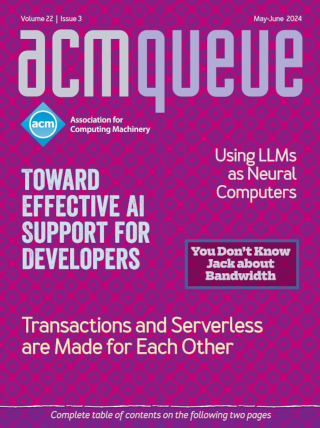
Cold, Hard Cache:
On the implementation and maintenance of caches
Dear KV, Our latest project at work requires a large number of slightly different software stacks to deploy within our cloud infrastructure. With modern hardware, I can test this deployment on a laptop. The problem I keep running up against is that our deployment system seems to secretly cache some of my files and settings and not clear them, even when I repeatedly issue the command to do so. I’ve resorted to repeatedly using the find command so that I can blow away the offending files. What I’ve found is that the system caches data in many places so I’ve started a list. All of which brings me to my question: Who writes this stuff?!
Private Online Communication; Highlights in Systems Verification:
The importance of private communication will continue to grow. We need techniques to build larger verified systems from verified components.
First, Albert Kwon provides an overview of recent systems for secure and private communication. Second, James Wilcox takes us on a tour of recent advances in verified systems design.
XML and JSON Are Like Cardboard:
Cardboard surrounds and protects stuff as it crosses boundaries.
In cardboard, the safety and care for stuff is the important reason for its existence. Similarly, in XML and JSON the safety and care of the data, both in transit and in storage, are why we bother.
Network Applications Are Interactive:
The network era requires new models, with interactions instead of algorithms.
The miniaturization of devices and the prolific interconnectedness of these devices over high-speed wireless networks is completely changing how commerce is conducted. These changes (a.k.a. digital) will profoundly change how enterprises operate. Software is at the heart of this digital world, but the software toolsets and languages were conceived for the host-based era. The issues that already plague software practice (such as high defects, poor software productivity, information vulnerability, poor software project success rates, etc.) will be more profound with such an approach. It is time for software to be made simpler, secure, and reliable.
Cache Me If You Can:
Building a decentralized web-delivery model
The world is more connected than it ever has been before, and with our pocket supercomputers and IoT (Internet of Things) future, the next generation of the web might just be delivered in a peer-to-peer model. It’s a giant problem space, but the necessary tools and technology are here today. We just need to define the problem a little better.
Bitcoin’s Academic Pedigree:
The concept of cryptocurrencies is built from forgotten ideas in research literature.
We’ve seen repeatedly that ideas in the research literature can be gradually forgotten or lie unappreciated, especially if they are ahead of their time, even in popular areas of research. Both practitioners and academics would do well to revisit old ideas to glean insights for present systems. Bitcoin was unusual and successful not because it was on the cutting edge of research on any of its components, but because it combined old ideas from many previously unrelated fields. This is not easy to do, as it requires bridging disparate terminology, assumptions, etc., but it is a valuable blueprint for innovation.
Breadth and Depth:
We all wear many hats, but make sure you have one that fits well.
When people ask me the question of where they should focus their time I ask them what is the one thing you could be the best in the world at? The answer might be going deep or going wide. The important thing is to spend your time on building the skills that will move you to where to you want to go.





